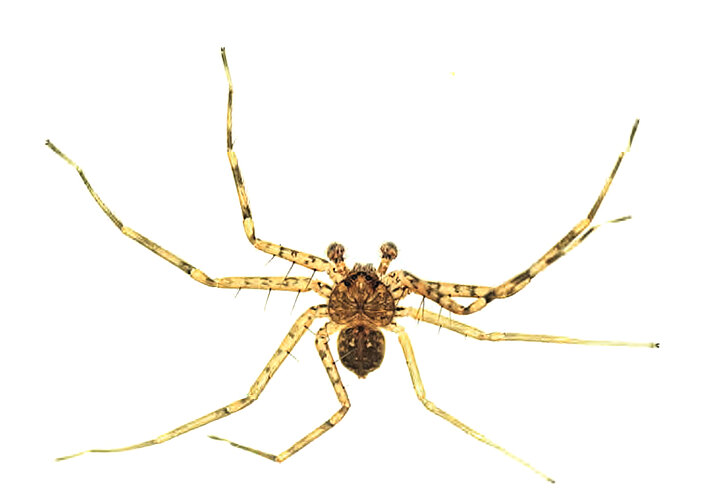Banyjima Flattie Karaops banyjima Crews, 2013
Fauna Portal species: 8924Diagnosis
(after Crews 2023): The female of K. banyjima is somewhat similar to Karaops burbidgei by the location of the copulatory openings and the general shape of the structures of the endogyne. In K. banyjima, however, the copulatory openings are located in a depression that is m-shaped along the top margin and w-shaped along the bottom margin, the ducts connecting the spermathecae and the accessory bulbs are not twisted, and the spermathecae and accessory bulbs are highly sclerotized.
The male is most similar to Karaops nyangumarta, but the two species can be differentiated by the tegular lobe, the median apophysis, the conductor, and the dorsal retrolateral tibial apophysis (dRTA). In K. banyjima, the narrowing of the tegular lobe to the embolus is nearly midway from the basal and distal portions of the bulb. In K. nyangumarta, this point is in the basal third of the bulb. The median apophysis of K. banyjima has no spinules, and the median apophysis of K. nyangumarta has a dense array of spinules. The conductor of K. banyjima does not reach the retrolateral edge of the bulb, and the tip is directed laterally, whereas in K. nyangumarta, the conductor reaches the retrolateral side of the bulb, and the tip of the conductor is directed ventrally. The dRTA of K. banyjima is rather short and stout (but not like a little teapot), whereas that of K. nyangumarta is longer, narrower, and curved slightly ventrally. It is somewhat difficult to distinguish the two in life by the abdominal pattern, but K. nyangumarta males have more mottling dorsally on the abdomen.
Status
- native
Linnean Holotype
Australia
- Western Australia
Fauna Portal Records
The map shows all records that have been verified as part of the Fauna Portal project and may not represent the true distribution of a species. Specifically, for described species, check the link to the Atlas of Living Australia on this page for potential wider distributions. Fauna Portal Reference specimens and Linnean types are shown in red. If you identified a specimen that exceeds the distribution of an undescribed species as illustrated here, please contact the Fauna Portal team who can assist with the lodgement of the specimen in a public institution and display on the map.
Publications
Crews S.C. (2013): Thirteen new species of the spider genus Karaops (Araneae: Selenopidae) from Western Australia. Zootaxa. 3647: 443 - 469
Crews SC (2023): But wait, there’s more! Descriptions of new species and undescribed sexes of flattie spiders (Araneae, Selenopidae, Karaops) from Australia. ZooKeys. 1150: 1 - 189WEB
TGGTTTTTGGAGCTTGATCTGCTATGGTGGGGACAGCTATAAGAGTTTTAATTCGAATGGAACTGGGTCCAGACTGGAAGATTTTTGGGAGATGATCATATATATAATGTTATTGTTACAGCACATGCTTTTGTTATGATTTTTTTTATAGTAATGCCTATTTTGATTGGAGGGTTTGGAAATTGATTAATCCCATTAATGTTGGGAGCTCCAGATATAGCTTTTCCTCGTATAAATAATTTAAGTTTTTGATTATTACCTCCTTCTTTAATATTGTTATTTATTTCATCAATAGTAGAAATAGGGGNTGGTGCAGGATGAACAGTTTATCCTCCTTTAGCAAGAGTTATAGGACATGCTGGGAGTGCTGTTGATTTTGCAATTTTTTCTTTACATTTGGCTGGTGCTTCCTCTATTATAGGGGCTGTAAATTTTATTTCTACTGTAATTAATATACGTTCTGTAGGTATATCAATGGAAAAAGTTCCTTTATTTGTATGATCCGTATTTATTACGGCTATTTTATTGTTGTTATCGTTGCCAGTTTTAGCAGGGGCAATTACTATATTATTAACTGATCGGAACTTTAATACTTCTTTTTTTGATCCTGCTGGGGGTGGTGATCCAATTTTGNTTCAACATTTATTT
ACTGGGAGATTTTTAGGAGATGATCATATATATAATGTTATTGTTACTGCTCATGCTTTTGTTATAATTTTTTTTATAGTAATACCTATTTTGATTGGAGGATTTGGGAACTGATTAATTCCGTTGATGTTAGGGGCTCCGGATATGGCTTTTCCTCGTATAAATAATTTAAGTTTTTGATTACTTCCGCCTTCTTTGATATTATTATTTATTTCATCAATGGTAGAAATAGGGGTTGGAGCTGGGTGAACAGTGTATCCTCCTTTAGCAAGAGTTATAGGGCATGCTGGAAGTGCTGTTGATTTTGCTTTTTTTTCTTTAAATTTAGCTGGTGCTTCTTCTATTATAGGAGCTGTAAATTTTATTTCTACTGTAATTAATATGCGTTCTGTAGGGATATCAATGGAAAAGAACCTTTATTTGTGTGATCTGTTTTTATTACAGCTATTTTGTTATTATTATCATTGCCTGTTCTAGCTGGGGCTATTACTATATTATTGACTGATCGAAATTTTAATACTTCTTTCTTTGATCCTGCTGGGGGAGGGGATCCAATTTTATTTCAACATTTATTTTGATTTTTTGGTC
Araneae (Spiders)
- Actinopodidae
- Anamidae
- Araneae fam. indet.
- Araneidae
- Archaeidae
- Argyronetidae
- Arkyidae
- Barychelidae
- Cheiracanthiidae
- Clubionidae
- Corinnidae
- Cycloctenidae
- Deinopidae
- Desidae
- Dictynidae
- Filistatidae
- Gnaphosidae
- Halonoproctidae
- Hersiliidae
- Idiopidae
- Lamponidae
- Linyphiidae
- Lycosidae
- Mimetidae
- Miturgidae
- Mysmenidae
- Nicodamidae
- Oecobiidae
- Oonopidae
- Oxyopidae
- Philodromidae
- Pholcidae
- Pisauridae
- Prodidomidae
- Salticidae
- Scytodidae
- Segestriidae
- Selenopidae
- Sparassidae
- Symphytognathidae
- Tetrablemmidae
- Tetragnathidae
- Theridiidae
- Thomisidae
- Trachelidae
- Trachycosmidae
- Trochanteriidae
- Uloboridae
- Zodariidae
- Zoropsidae
All classes
- Arachnida
- Crustacea
- Entognatha
- Gastropoda
- Insecta
- Orthoptera - Caelifera (Grasshoppers)
- Hymenoptera excl. Formicidae (bees and wasps)
- Blattodea s. str. (Cockroaches)
- Coleoptera (Beetles)
- Dermaptera (earwigs)
- Diptera (flies, mosquitos)
- Entomobryomorpha (slender springtails)
- Hemiptera - Heteroptera (True Bugs)
- Hemiptera - Sternorrhyncha (aphids, scales etc.)
- Hemiptera - Auchenorrhyncha (cicadas, planthoppers)
- Hymenoptera - Formicidae (Ants)
- Trichoptera (Caddisflies)
- Zygentoma (silverfish)
- Myriapoda

